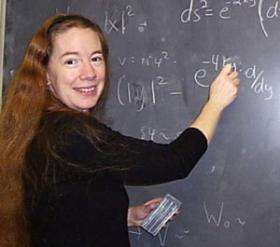SLAC Physicists Develop Test For String Theory*

*Under Certain Conditions
String theory solves many of the questions wracking the minds of physicists, but it has one major flaw — there are currently no known methods to test it. SLAC scientists have found a way to test a particular version of this revolutionary theory. The test applies to a class of critical string theories which posit that there are 10 or 11 dimensions in our universe — no more, no less.
This past December, Joanne Hewett, Thomas Rizzo and student Ben Lillie published an article in Physical Review Letters which shows theoretically how to measure the number of dimensions that comprise the universe. By determining how many dimensions exist, Hewett, Lillie and Rizzo hope to either confirm or repudiate critical string theory under specific conditions.
The first three dimensions, length, height and width, are familiar to all of us. The fourth dimension is time. But what are the extra dimensions? "Imagine a tightrope stretched between skyscrapers," says Hewett. "If you are watching an acrobat walk across it — the tightrope looks like a line. But if you are watching an ant walk on the tightrope, you can see that the tightrope is thick and round." The extra dimensions postulated in string theory are like the tightrope with an ant on it; they are too small to see unless you get really, really close.
Hewett, Lillie and Rizzo found that if so called micro-black holes, which are smaller than the nucleus of an atom, exist, they can be used to determine the number of extra dimensions. If scientists were to smash two high energy protons together they could theoretically make such a micro-black hole. Such a collision could happen at CERN’s Large Hadron Collider (LHC), which will become operational next year. Once created, the micro-black hole decays quickly and emits over a dozen different kinds of particles such as electrons, neutrinos and photons, which are easy to detect. Using the predicted decay properties of the black hole into neutrinos, Hewett, Lillie and Rizzo solved complex equations to determine if our universe has 10, 11, or more dimensions — perhaps too many dimensions to be explained by critical string theory.
More technically, the analysis applies to models of extra dimensions where micro-black holes can be formed with a size smaller than the curvature of the additional dimensions and where the fundamental particles which make up our universe do not reside in the extra dimensions. These micro-black holes must also exist at an energy scale which can be probed at the LHC. Under those very specific conditions, the test holds. These conditions are possible within string theory, but need not be present.
"The computations were so massive, we had to make extreme use of the Babar UNIX farm," said Rizzo.
Of course, string theory hasn't been tested yet — experimental evidence is necessary. Additionally, Hewett, Lillie and Rizzo’s analysis can only disprove critical string theory; it cannot prove it.
"If they see black holes at the LHC, they’ll definitely do this analysis," says Hewett. "This would tell us about the fundamental nature of the universe."
Note: This article has been revised to contain more technical information.
Source: Stanford Linear Accelerator Center

















